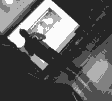|
è una selezione di testi che contestualizzano i progetti
invitati a d-i-n-a, sottolineando il legame diretto fra
evoluzione sociale, visibilità pubblica, problemi
di proprietà del sapere, dinamiche dei flussi dell'informazione-potere.
(traduzioni italiane di d-i-n-a) |
| |

The
Liar's Poker
by Brian Holmes
(2003)
" Basically, what I have to say here
is simple: when people talk about politics in an artistic
frame, they're lying. " |

The
GNU Project
by Richard Stallman
(1998)
"The idea that the proprietary-software social system--the
system that says you are not allowed to share or change
software--is antisocial, that it is unethical, that it is
simply wrong, may come as a surprise to some readers. But
what else could we say about a system based on dividing
the public and keeping users helpless? Readers who find
the idea surprising may have taken proprietary-software
social system as given, or judged it on the terms suggested
by proprietary software businesses. Software publishers
have worked long and hard to convince people that there
is only one way to look at the issue."
|

The
Conquest of Cool
by Thomas Frank
(1997)
A exemplary excerpt from a book about the co-optation of US
hip cultures in the business empire in the 60s. What kinds
of tensions and bonds exist between counter-cultures and consumer
cultures? What happens when alternative styles enter the business
domain? Thomas Frank, a US journalist, gives some insight
on "the genesis of counterculture as an enduring commercial
myth" which recurs throughout post-sixties culture. |

Digital
resistance
by Critical Art Ensemble (2001)
"Digital resistance"
- whose Introduction is translated and presented here - is
a recent book by Critical Art Ensemble, a U.S. based collective
of artists/thinkers which deeply influenced a whole scene
of activists and artists working with digital technologies
in the political and social arena. |

Software
art
by Florian Cramer
e Ulrike Gabriel
(2001)
A text about the importance of code writing in the transformation
of contemporary artistic practices. Jurors for the 2001 edition
of the Transmediale festival, the authors are key figures
of the Berlin media cultures. |

The
XYZ of Net Activism
by Luther Blissett
(1999)
"Hybridisation is not about just connecting
the virtual and the "street". We risk to remain
rhetoric and predictable on both the fronts. We have to hybridize
and to contaminate the forms of pop culture to create pop
modules for activism." |

A
post-media aesthetics
by Lev Manovich
(2000)
On how digital communications technologies ultimately question
the traditional categories of medium-based art and mass vs.
high culture. In Manovich's view, data processing is the key
factor of a radically new way of approaching creation, not
only in the field of computer science.
Manovich teaches at the University of California San Diego.
|

Game
Patch - Son of scratch?
by Erkki Huhtamo
(1999)
An early text about videogames modifications, drawing a revealing
connection between the creation of alternative videogames
patches and the 80s phenomenon of scratch video, both seen
as an autonomous and "tactical way of (mis)using popular
media. Huhtamo is a professor at US and Finnish univerisities. |

Fast,
Cheap and out of control
by Timothy Druckrey (2002)
|

The fake persuaders
by George Monbiot (2002)
A real account of how information can be used as a virus
and who is playing with it (in this case in the biotech
debate).
George Monbiot is an investigative journalist from the UK
newspaper The Guardian.
|

Transfiguration
of the Avant-Garde / The Negative Dialectics of the Net
by Eric Kluitenberg
(2001)
An approach to classical "net.art" as new and
innovative examples of cross-over between defunct art avant-garde
and media experimentation.
Eric Kluitemberg teaches at the University of Amsterdam
and is director of activities at the new media center De
Balie (Amsterdam).
|












![]()